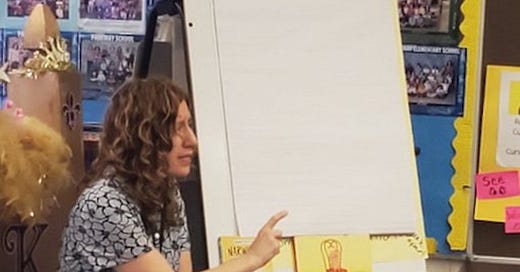This post is free to read, so please ‘like’ it via the heart below and share it widely. The best way to support my work is with a paid subscription.
Recently, I shared a social media post about a structured approach to word study, and the response was overwhelming. It’s clear that many educators are looking for practical ways to weave vocabulary, spelling, reading, and writing into a single, efficient lesson. In the spirit of testing this with real students, let me share how this played out in a 5th grade classroom.
A Word Study Lesson in Action
Students were learning about the Stone Age. We used this as an opportunity to dig into the word survived—a word that not only tied directly to their unit but also provided rich opportunities for spelling, morphology, and sentence-level work.
We started by defining survived and discussing why it was a precise word in this context. The class explored what it means to survive and connected it to what they had learned about early humans.
Then, we broke the word into syllables: sur-vived.
From there, we analyzed its structure (morphology):
Base : viv. from Latin vivere, meaning "to live")
Prefix: sur- (from Latin super, meaning "over, above, beyond")
Suffix: -ed (showing past tense)
This deep dive into the word helped the students have a deeper understanding of survived and how it’s different from simply living during the Stone Age.
Step 2: Pronunciation Matters
One key focus was on how the -ed ending is pronounced in this word. Unlike some past-tense words where -ed sounds like /t/ (e.g., jumped) or /ɪd/ (e.g., rested), in survived, the -ed is pronounced /d/: sur-vived.
We talked about why this happens—when a verb ends in a voiced sound like /v/, the past tense -ed is pronounced as /d/ rather than /t/ or /ɪd/. The students practiced saying the word aloud, emphasizing that smooth /d/ sound at the end.
Step 3: Spelling
Next, students wrote the word:
First, breaking it into syllables (sur – vived).
Then, writing it as a whole word.
Step 4: Sentence Expansion (Writing)
To bring everything together, students read an article about the Stone Age and then worked on a sentence expansion activity. They started with the simple sentence:
Hunters and gatherers survived.
Then, using information from the text, they expanded it by answering:
When? (during the Ice Age)
Why? (because they adapted to their environment)
How? (by learning to hunt and build shelters)
Where? (in harsh, cold climates)
Some students also added adjectives and adverbs for even more detail. The final sentences reflected deep engagement with the content and stronger command of syntax.
Why This Approach Works
This structured lesson seamlessly integrated multiple literacy skills:
✅ Spelling—breaking the word into syllables and writing it accurately.
✅ Reading—encountering the word in context.
✅Morphology-Noticing the base, the prefix and the suffix
✅ Knowledge Building—connecting the word to their learning about early humans.
✅ Sentence Syntax—expanding sentences to develop complexity.
✅ Pronunciation—understanding how past tense -ed endings change depending on the word’s final sound.
Jim Knight highlights the impact of instructional playbooks—concise, research-backed guides that help schools align on practices that make a real difference for students. Here’s one tool for your instructional playbook:
1️⃣ Introduce a word connected to your content area.
2️⃣ Define the word for clear understanding.
3️⃣ Analyze the spelling, syllable by syllable.
4️⃣ Focus on pronunciation.
5️⃣ Examine its morphology—unpacking roots and affixes.
6️⃣ Engage in sentence-level activities (try sentence combining or “because, but, and so” exercises!).
This sequence provides a powerful framework for helping students connect language and content in meaningful ways.
If this instructional playbook resonates with you, please consider upgrading to a paid subscription.
The paid subscription includes one literacy instructional playbook a week.
I’d love to help you customize it for your school or district.
📌 Want direct support? I offer coaching sessions to help teams develop strong, sustainable coaching models.
📌 Need more playbooks? My Literacy Toolkit has templates, planning guides and curated videos designed to support that work.
📌And check out my newest book, "We-Do" Writing for a research aligned framework for how to support writing instruction and curriculum.
📌Want some great books on vocabulary? Beneath The Surface of Words and a A Teacher's Guide To Vocabulary Development Across The Day are two of my favorites.





This is how I try to teach myself new words in a different language:)
Thanks for sharing!